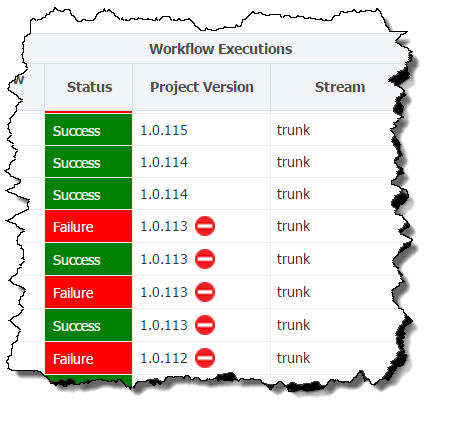The Purge Settings define the configuration parameters to manage the archiving and purging of FlexDeploy execution data from the database repository, and purging of the artifacts stored in the artifacts repository.
| Property | Description |
|---|---|
Purge Enabled | Indicates whether the purge process is enabled |
Retention Days (Operational) | How many days of execution data to keep in the operational tables |
Retention Days (Artifacts) | How many days of artifacts to keep in the file system |
Keep Count | How many project versions to keep for each environment/instance regardless of |
Keep Success Count | How many successful project version builds to keep regardless of |
Keep Failed Count | How many failed project version builds to keep regardless of |
Retention Days (Archive) | How many days of execution data to keep in the archive tables |
| Retention Days for Logs | How many days of execution data to keep in the log tables |
| Number of successful pipeline executions to keep | Number of successful of running pipeline executions to keep in operational tables. |
| Number of unsuccessful pipeline executions to keep | Number of aborted, failed , skipped, or out-of-date pipeline executions to keep in operational tables. |
Purge Rules
- Any workflow execution that is the last successful deployment to an environment is automatically excluded from the purge.
- The three KEEP related parameters override the
DAYSparameter (i.e. ifRetention Days (Operational)is 1 day, anything that was deployed more than 1 day ago AND is one that needs to be kept to satisfy theKEEPparameters will be excluded from the archive/purge). - The
Retention Days (Artifacts)only affects the removal of the artifacts from the file system. There is no archive of artifacts. TheKEEPparameters will again override the artifact retention days. When the artifacts have been purged, a red circle will appear on the project version (as shown in figure 17.28) indicating that the artifacts have been purged. This project version will also no longer be available to deploy to any environment. To redeploy this version, the version of the source would need to be retrieved from source code repository (like SVN) in use and taken through the build/deploy cycle again. - The
Retention Daysare based on the first date it finds in this sequence: End time of the workflow execution, start time of the workflow execution, created time of the workflow execution, requested start time of the workflow request, or the created time of the workflow request.
Examples of configuring the purge
Scenario 1: Retain the last 3 successful builds in each environment/instance and keep the last 12 successful builds and last 2 failed builds overall. Artifacts will be purged from the file system after 15 days and execution data will be archived after 30 days. Data will remain in the archive for 365 days.
Scenario 2: Retain 60 days of execution data and artifacts
Understanding the purge KEEP parameters
Project Deployments:
| Environment | DEV | QA | PROD |
|---|---|---|---|
| Project Versions | v9 (Failed) | ||
| v10 | v10 | v10 | |
| v13 | v13 | ||
| v15 | v15 | ||
| v16 | |||
| v17 | |||
| v18 (Failed) | |||
| v19 |
Properties:
| Property | Value | Versions Retained due to property value |
|---|---|---|
| Keep Count | 2 | v11, v12, v14, v15, v17, v19 |
| Keep Success Count | 4 | v15, v16, v17, v19 |
| Keep Failed Count | 1 | v18 |
| DEPLOYED TO AN ENVIRNOMENT | AUTOMATIC | v12, v15, v19 |
Retention Days would be v9, v10, and v13. Those three versions will only be purged/archived in they are older than the retention days parameters.
